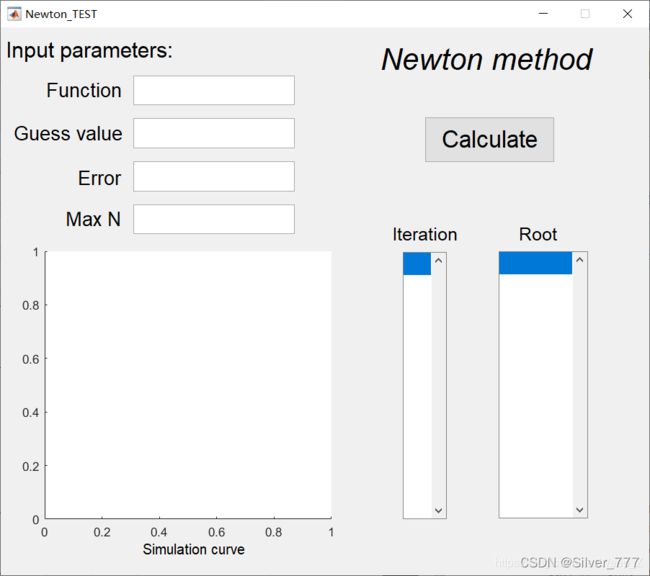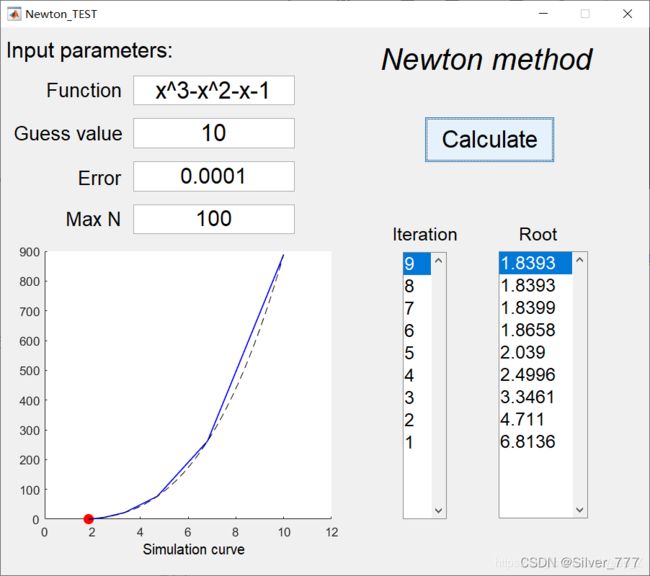Matlab牛顿迭代法求方程的根(GUI)
牛顿迭代法的具体内容不赘述
它的核心算法是:
k = 1;
x = x0;
x0 = x + e*2; % 为了让初启动时满足循环条件
while (abs(x-x0))>e && (k<=N) % 同时限定误差和最大循环次数
x0 = x;
x = x0 - f(x0)/df(x0); % 牛顿迭代法式子
k = k+1;
end
这是一个非常简单的牛顿法实现,根据上学期学的数值分析和这学期上的Matlab,把它用GUI简单包装了一下。
用户输入函数表达式、初值、最大容许误差、最大循环次数之后,就可以计算根。代码实现如下。
function varargout = Newton_TEST(varargin)
% NEWTON_TEST MATLAB code for Newton_TEST.fig
% NEWTON_TEST, by itself, creates a new NEWTON_TEST or raises the existing
% singleton*.
%
% H = NEWTON_TEST returns the handle to a new NEWTON_TEST or the handle to
% the existing singleton*.
%
% NEWTON_TEST('CALLBACK',hObject,eventData,handles,...) calls the local
% function named CALLBACK in NEWTON_TEST.M with the given input arguments.
%
% NEWTON_TEST('Property','Value',...) creates a new NEWTON_TEST or raises the
% existing singleton*. Starting from the left, property value pairs are
% applied to the GUI before Newton_TEST_OpeningFcn gets called. An
% unrecognized property name or invalid value makes property application
% stop. All inputs are passed to Newton_TEST_OpeningFcn via varargin.
%
% *See GUI Options on GUIDE's Tools menu. Choose "GUI allows only one
% instance to run (singleton)".
%
% See also: GUIDE, GUIDATA, GUIHANDLES
% Edit the above text to modify the response to help Newton_TEST
% Last Modified by GUIDE v2.5 12-Mar-2020 23:03:08
% Begin initialization code - DO NOT EDIT
gui_Singleton = 1;
gui_State = struct('gui_Name', mfilename, ...
'gui_Singleton', gui_Singleton, ...
'gui_OpeningFcn', @Newton_TEST_OpeningFcn, ...
'gui_OutputFcn', @Newton_TEST_OutputFcn, ...
'gui_LayoutFcn', [] , ...
'gui_Callback', []);
if nargin && ischar(varargin{1})
gui_State.gui_Callback = str2func(varargin{1});
end
if nargout
[varargout{1:nargout}] = gui_mainfcn(gui_State, varargin{:});
else
gui_mainfcn(gui_State, varargin{:});
end
% End initialization code - DO NOT EDIT
% --- Executes just before Newton_TEST is made visible.
function Newton_TEST_OpeningFcn(hObject, eventdata, handles, varargin)
% This function has no output args, see OutputFcn.
% hObject handle to figure
% eventdata reserved - to be defined in a future version of MATLAB
% handles structure with handles and user data (see GUIDATA)
% varargin command line arguments to Newton_TEST (see VARARGIN)
handles.FUN = [];
handles.X0 = [];
% Choose default command line output for Newton_TEST
handles.output = hObject;
% Update handles structure
guidata(hObject, handles);
% UIWAIT makes Newton_TEST wait for user response (see UIRESUME)
% uiwait(handles.figure1);
% --- Outputs from this function are returned to the command line.
function varargout = Newton_TEST_OutputFcn(hObject, eventdata, handles)
% varargout cell array for returning output args (see VARARGOUT);
% hObject handle to figure
% eventdata reserved - to be defined in a future version of MATLAB
% handles structure with handles and user data (see GUIDATA)
% Get default command line output from handles structure
varargout{1} = handles.output;
function editFUN_Callback(hObject, eventdata, handles)
% hObject handle to editFUN (see GCBO)
% eventdata reserved - to be defined in a future version of MATLAB
% handles structure with handles and user data (see GUIDATA)
% Hints: get(hObject,'String') returns contents of editFUN as text
% str2double(get(hObject,'String')) returns contents of editFUN as a double
handles.FUN = get(hObject,'String');
guidata(hObject, handles);
% --- Executes during object creation, after setting all properties.
function editFUN_CreateFcn(hObject, eventdata, handles)
% hObject handle to editFUN (see GCBO)
% eventdata reserved - to be defined in a future version of MATLAB
% handles empty - handles not created until after all CreateFcns called
% Hint: edit controls usually have a white background on Windows.
% See ISPC and COMPUTER.
if ispc && isequal(get(hObject,'BackgroundColor'), get(0,'defaultUicontrolBackgroundColor'))
set(hObject,'BackgroundColor','white');
end
function editX0_Callback(hObject, eventdata, handles)
% hObject handle to editX0 (see GCBO)
% eventdata reserved - to be defined in a future version of MATLAB
% handles structure with handles and user data (see GUIDATA)
% Hints: get(hObject,'String') returns contents of editX0 as text
% str2double(get(hObject,'String')) returns contents of editX0 as a double
handles.X0 = str2num(get(hObject,'String'));
guidata(hObject, handles);
% --- Executes during object creation, after setting all properties.
function editX0_CreateFcn(hObject, eventdata, handles)
% hObject handle to editX0 (see GCBO)
% eventdata reserved - to be defined in a future version of MATLAB
% handles empty - handles not created until after all CreateFcns called
% Hint: edit controls usually have a white background on Windows.
% See ISPC and COMPUTER.
if ispc && isequal(get(hObject,'BackgroundColor'), get(0,'defaultUicontrolBackgroundColor'))
set(hObject,'BackgroundColor','white');
end
function editError_Callback(hObject, eventdata, handles)
% hObject handle to editError (see GCBO)
% eventdata reserved - to be defined in a future version of MATLAB
% handles structure with handles and user data (see GUIDATA)
% Hints: get(hObject,'String') returns contents of editError as text
% str2double(get(hObject,'String')) returns contents of editError as a double
handles.ERROR = str2num(get(hObject,'String'));
guidata(hObject, handles);
% --- Executes during object creation, after setting all properties.
function editError_CreateFcn(hObject, eventdata, handles)
% hObject handle to editError (see GCBO)
% eventdata reserved - to be defined in a future version of MATLAB
% handles empty - handles not created until after all CreateFcns called
% Hint: edit controls usually have a white background on Windows.
% See ISPC and COMPUTER.
if ispc && isequal(get(hObject,'BackgroundColor'), get(0,'defaultUicontrolBackgroundColor'))
set(hObject,'BackgroundColor','white');
end
function editN_Callback(hObject, eventdata, handles)
% hObject handle to editN (see GCBO)
% eventdata reserved - to be defined in a future version of MATLAB
% handles structure with handles and user data (see GUIDATA)
% Hints: get(hObject,'String') returns contents of editN as text
% str2double(get(hObject,'String')) returns contents of editN as a double
handles.N = str2num(get(hObject,'String'));
guidata(hObject, handles);
% --- Executes during object creation, after setting all properties.
function editN_CreateFcn(hObject, eventdata, handles)
% hObject handle to editN (see GCBO)
% eventdata reserved - to be defined in a future version of MATLAB
% handles empty - handles not created until after all CreateFcns called
% Hint: edit controls usually have a white background on Windows.
% See ISPC and COMPUTER.
if ispc && isequal(get(hObject,'BackgroundColor'), get(0,'defaultUicontrolBackgroundColor'))
set(hObject,'BackgroundColor','white');
end
% --- Executes on selection change in listboxK.
function listboxK_Callback(hObject, eventdata, handles)
% hObject handle to listboxK (see GCBO)
% eventdata reserved - to be defined in a future version of MATLAB
% handles structure with handles and user data (see GUIDATA)
% Hints: contents = cellstr(get(hObject,'String')) returns listboxK contents as cell array
% contents{get(hObject,'Value')} returns selected item from listboxK
% --- Executes during object creation, after setting all properties.
function listboxK_CreateFcn(hObject, eventdata, handles)
% hObject handle to listboxK (see GCBO)
% eventdata reserved - to be defined in a future version of MATLAB
% handles empty - handles not created until after all CreateFcns called
% Hint: listbox controls usually have a white background on Windows.
% See ISPC and COMPUTER.
if ispc && isequal(get(hObject,'BackgroundColor'), get(0,'defaultUicontrolBackgroundColor'))
set(hObject,'BackgroundColor','white');
end
% --- Executes on selection change in listboxX.
function listboxX_Callback(hObject, eventdata, handles)
% hObject handle to listboxX (see GCBO)
% eventdata reserved - to be defined in a future version of MATLAB
% handles structure with handles and user data (see GUIDATA)
% Hints: contents = cellstr(get(hObject,'String')) returns listboxX contents as cell array
% contents{get(hObject,'Value')} returns selected item from listboxX
% --- Executes during object creation, after setting all properties.
function listboxX_CreateFcn(hObject, eventdata, handles)
% hObject handle to listboxX (see GCBO)
% eventdata reserved - to be defined in a future version of MATLAB
% handles empty - handles not created until after all CreateFcns called
% Hint: listbox controls usually have a white background on Windows.
% See ISPC and COMPUTER.
if ispc && isequal(get(hObject,'BackgroundColor'), get(0,'defaultUicontrolBackgroundColor'))
set(hObject,'BackgroundColor','white');
end
% --- Executes on button press in pushbuttonRUN.
function pushbuttonRUN_Callback(hObject, eventdata, handles)
% hObject handle to pushbuttonRUN (see GCBO)
% eventdata reserved - to be defined in a future version of MATLAB
% handles structure with handles and user data (see GUIDATA)
cla
f = handles.FUN;
x0 = handles.X0;
N = handles.N;
e = handles.ERROR;
f = eval(['@(x)',f]); % 将用户输入的str类型转化为有意义的匿名函数
df = eval(['@(x)',char(diff(sym(f)))]); % 计算微分
node = line(x0,f(x0),'Marker','o','MarkerSize',8,'MarkerFaceColor','r','MarkerEdgeColor','r');
connectline = line(x0,f(x0),'linewidth',1,'color','b'); %用来画连接的线
k = 1;
x = x0;
x0 = x+e*2;
K = [];
X = [];
xcon = x0;
ycon = f(x0);
while (abs(x-x0))>e && (k<=N)
x0 = x;
x = x0 - f(x0)/df(x0);
xcon = [xcon,x]; % 用将新的x值同旧值连接
ycon = [ycon,f(x)];
K = [{num2str(k)};K];
X = [{num2str(x)};X];
% 将循环结果呈现在界面
set(handles.listboxK,'string',K);
set(handles.listboxX,'string',X);
set(node,'xdata',x,'ydata',f(x));
set(connectline,'xdata',xcon,'ydata',ycon);
pause(0.5) % 为了能让人眼看到过程,用pause暂停0.5s
k = k+1;
end
hold on
xline = sort(xcon);
[xx,yy] = fplot(f,[min(xline),max(xline)]); %画出模拟曲线
plot(xx,yy,'--k');用一个的高次方程举例是这样
纯纯纯纯小白,发上来是希望可以互相交流,以及督促自己继续联系其他的数值方法。

